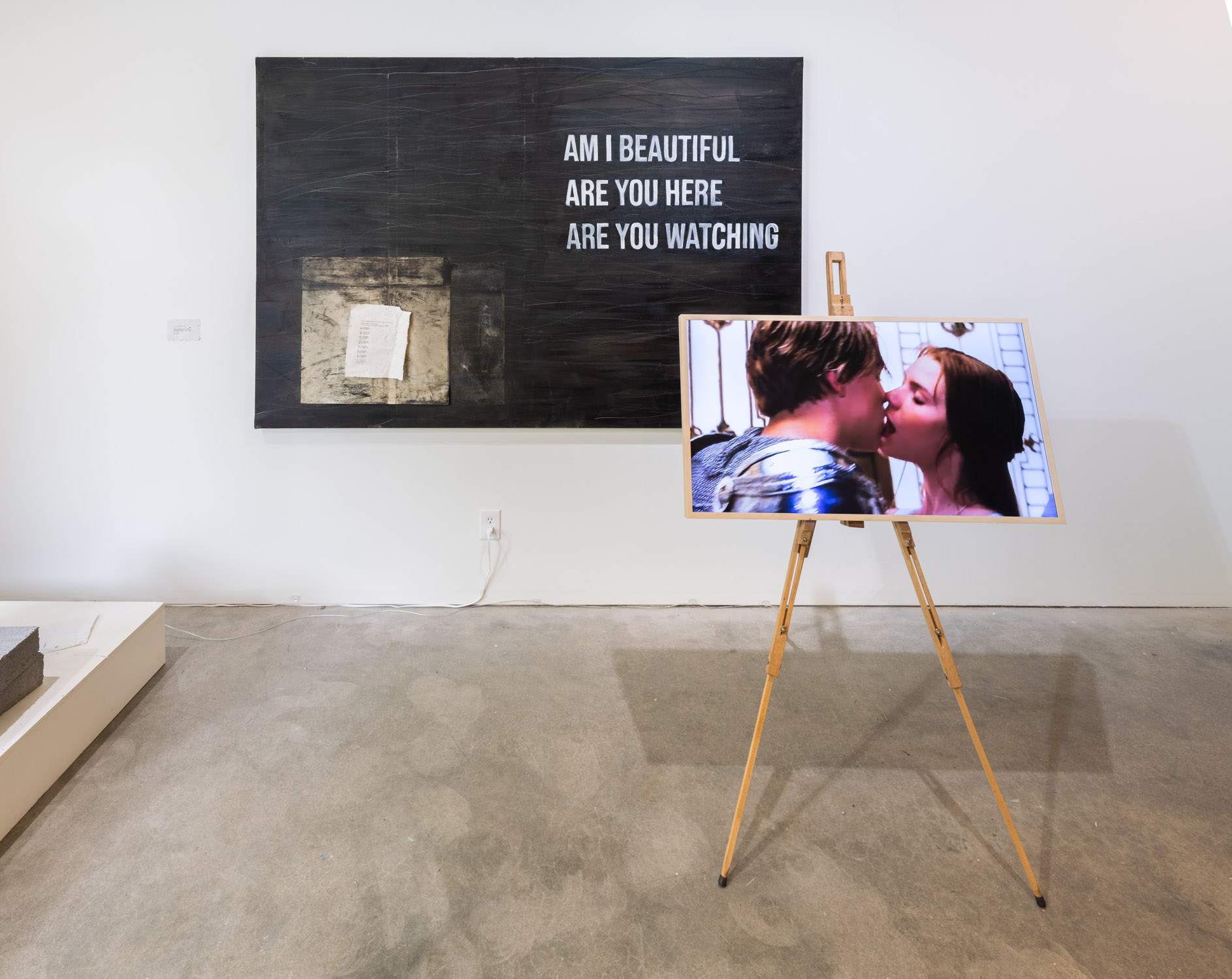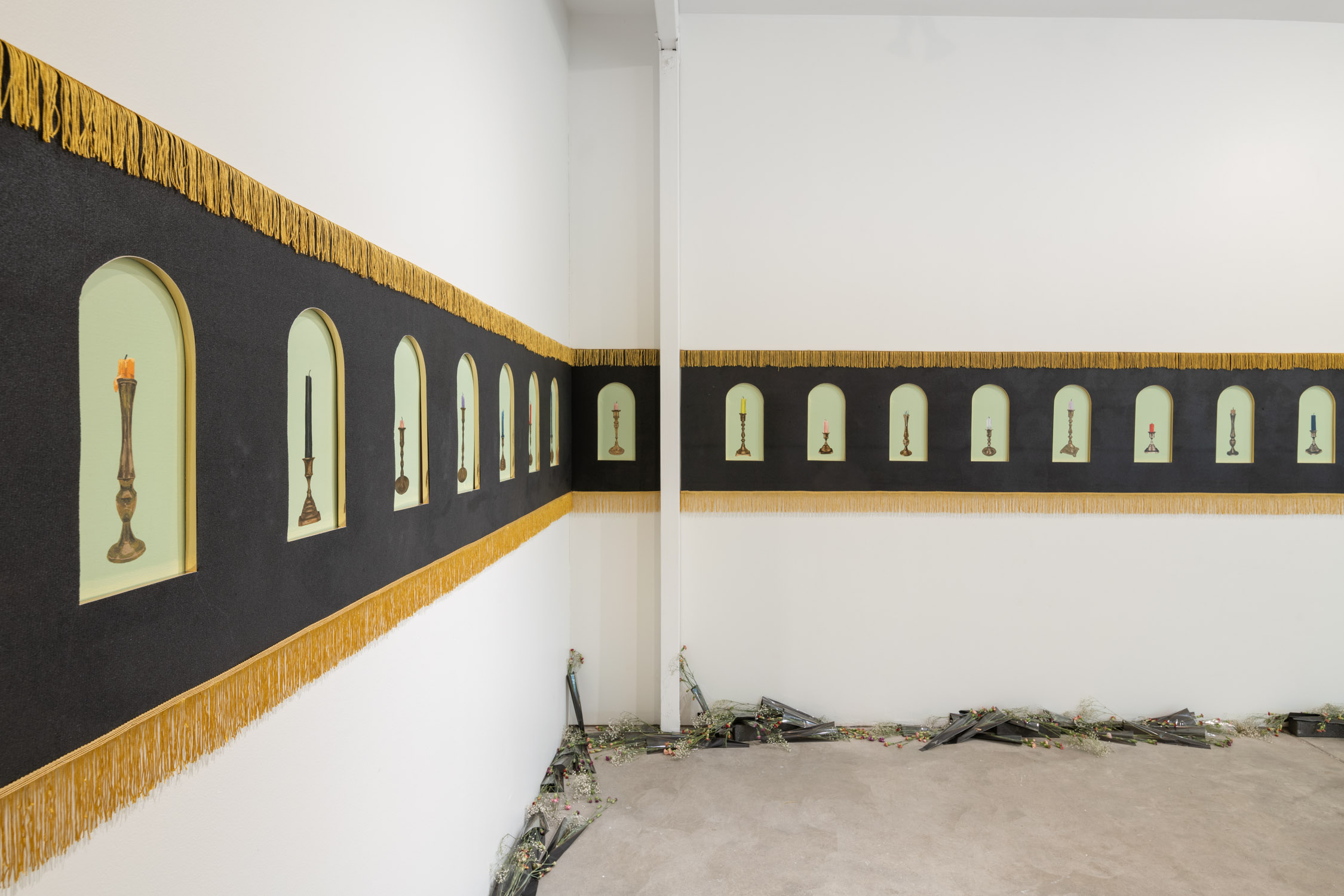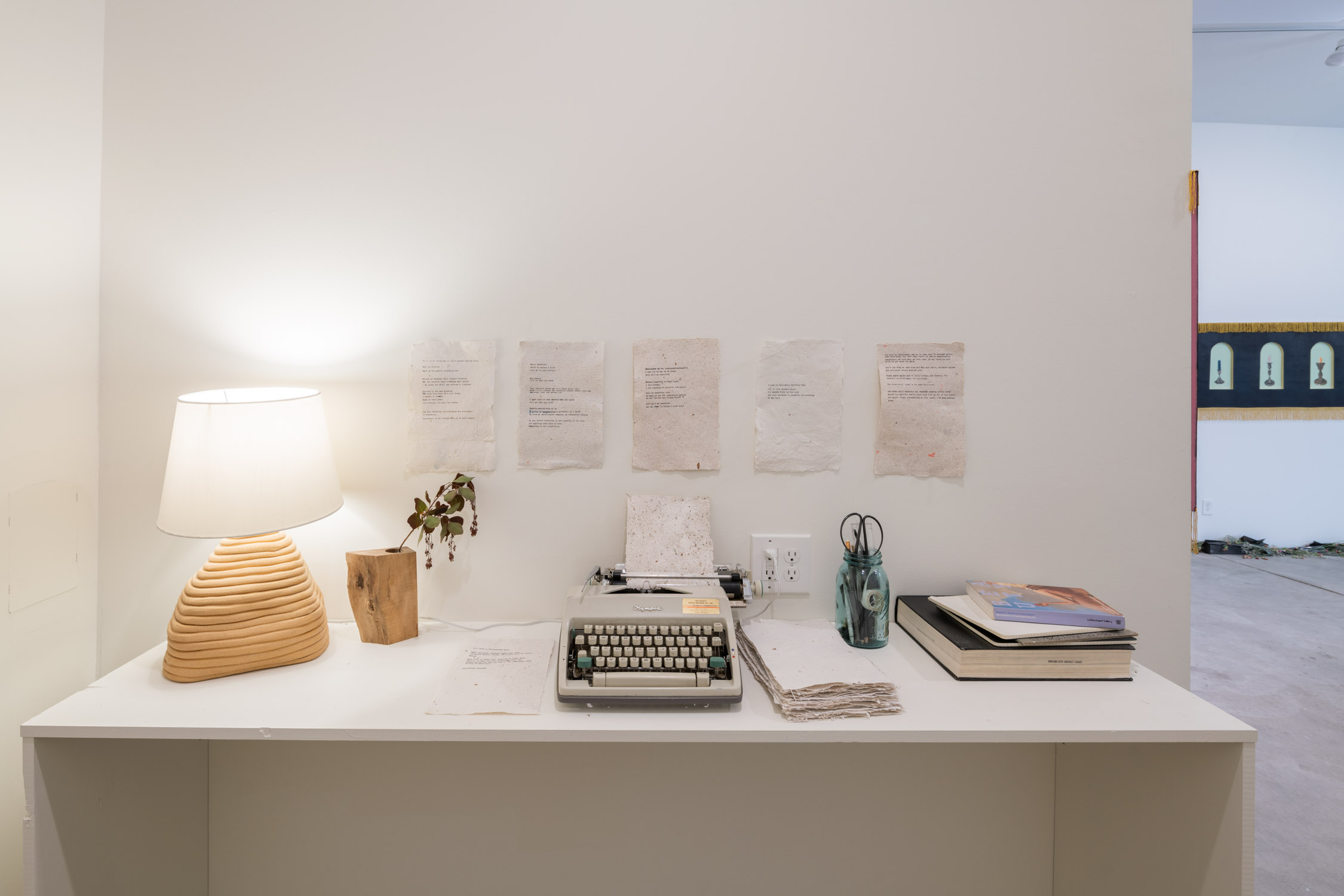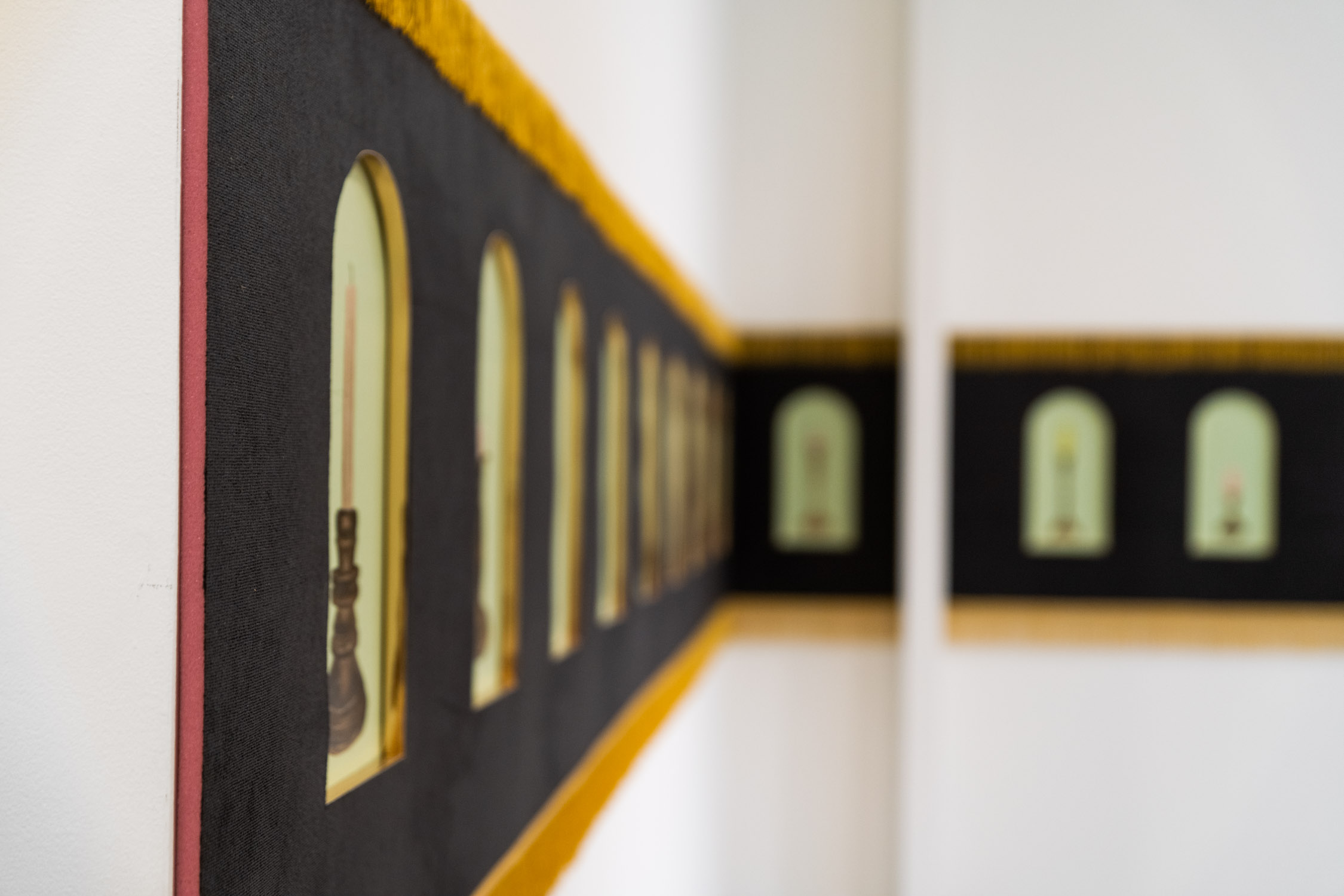Conversation
It’s Often a Performance and Little Star
Arts writer, artist, and arts activist Jennifer Rabin joined artists Leslie Vigeant and Brittney Connelly to discuss their two-person exhibition at Carnation Contemporary in May 2022. The following transcript is edited for length and clarity. The conversation begins with a toast.


Leslie Vigeant Well, this is a fun way to start!
So I have all of these oil paintings that I did . . . .
Jennifer Rabin Oh, they're oil.
LV Yeah, they're all oil.
Brittney Connelly Oh, that's beautiful, Leslie.
LV Thanks. I really like the larger piece. It looks like the candle and wilted tulip are kissing, but simultaneously the flower looks like a candle snuffer, which I like. There are 30 of these paintings.
JR Have you always used oils?
LV Yes and no. I've done watercolors before, but I definitely like oil the best. But I haven’t painted with oils in years at this point. So I’m returning to the practice with this show.
BC It's so interesting because there's an essence of time to burning the candles and oil painting. It is just so slow. There's a meditation that happens sitting there working with a material that takes a lot of time.
JR How was it getting back to painting after all this time?
LV It felt really healing. That's part of why I made this work. I wanted something that was digestible and small, that together created a whole. But also, I just needed something that was slow and meditative. I'm thinking of this show as a calendaring or a marking of time and energy.
LV There's so much symbolism behind a burnt candle that reflects how I've been feeling [since 2020]. The work acknowledges that I'm sad and I'm tired, but I'm also really lucky and hopeful. Painting again has felt like going back to my roots.
JR Last time we talked, you mentioned that there is significance to candles. I'm not sure if it's from your culture of origin, or where you come from geographically.
LV I grew up in a really small coastal town where women would put candles in the windows to help guide the fishing boats, with their husbands on them, home. It is an old-school symbol of loss and hope. The symbol of a candle is something I've been working with for a couple of years. I’ve also worked quite a bit with symbolism and flowers. In this piece, there's only that one flower and it's dead. It’s both kissing and snuffing the candle.
JR It's interesting because you mentioned that you refer to the tulip as a reference for potentially snuffing out the flame. When I saw it I thought about it in terms of the flame actually consuming the flower and burning it. What I thought about was the flower, it represents growth and life. Then there's potential destruction.
LV I love that read.

BC Let me show you what I have right here. I've been doing all these writings about love and the loss of love. They're all very intimate statements about this year for me. I went through this very dramatic breakup. I had an affair and all of these things were existing at once. It started making me think about where my work was at. I've always been an arms-length away from it, you know? At this point, I felt I wanted to create these very intimate pieces.
This piece, essentially, will have a reflection of the water projected on top of it. I went to Portugal and I made all these videos about water. With this piece anytime the projection is on it will display the water going in and out of this coastal area. At the point when the video ends, the screen will turn black and that’s when the text will be revealed.
A lot of the pieces are like this. I have this dining table that I segmented into thirds that has a peephole. Inside there's going to be an intimate video that you can only view through the opening. I want it to feel like a singular experience, or to be displayed in a way that reveals something hidden. I think that's just my reaction to how my circumstances have changed and shifted. I think that there are things that aren't even apparent, or that I can’t uncover myself. I don’t know. I'm really shooting from the hip and making these small works.
Also, every piece has an element. Like a nod to more classical subjects in painting. A still life, or something like that. I've got a bowl of fruit that's going to sit next to this video that's showing this thing called the orbital kiss. I don't know whether you know about the orbital kiss, but it's basically a movie trope. It’s where a couple kisses and the camera does this 360° revolution around them. I have a compilation of all these videos throughout history of the orbital kiss. What was so interesting is that when watching them I was so enamored by them, but I also had this direct rejection to feeling so captured by them as well. I think they do a good job of making you—as a human—want to connect. You want to have these relationships. I think as a woman they play on these tropes that really capture you, you know? There's a reason why we watch television shows with these formulas—we can't help but sink into them. I think in understanding these formulas, as an individual that doesn’t want to just absorb things, it helps to think about the structure more. It helps me to analyze my rejection of those things.
I'm playing a little bit with sentimentality. By being close to the work and having things hidden and revealed, I am also pulling back and analyzing my own sensibility to romance and love. I think that we do this with artwork too; the ideal of a still life painting, we romanticize all of it.
LV Ooooh, yeah!
BC For the exhibition, I have the steel piece with a poem on it, there’s a table I literally cut into thirds with the peephole, and I'll have some ceramic dish defying gravity with a video playing inside of it. This one is a poem I wrote at the beginning of when things started to fall apart. So I have all of these interesting pieces that reference our romanticism of art and our romanticism of the other. I'm playing a lot with forms and this idea of the hidden message. So even if the text is obscure and you have to look into the peephole to view the work, the written text of a poem is actually subtitled into the film. All the paper in the show is made from the pollen from my roof. I think of it as kind of poetic, sweet, and a little bit sad. I think as you walk through, you might notice a linear timeline of when things kind of broke down.
I guess a little bit of it talks about grief too.

JR And how has it been in terms of the actual process of making? You obviously both have very rigorous practices in terms of the conceptual basis of what you're making, but how has actually physically making these pieces been? Is it helping you to move through some of this grief and loss?
BC I think that there have been some “aha!” moments for myself. I think what I'm doing is trying to seek out my own answers through making. I'm not actually spending a lot of time conceptualizing. I'm spending a lot of time playing with these forms and just seeing what sits there. I think when you're so close to a circumstance or a situation, it's really hard to have your own bearing on what's going on. There's something in flux there that I can't quite reach or touch. Maybe there's a performance in observing your own stuff coming into these physical forms.
LV It's a witnessing. You can use these objects as a reflection of your own experience. But it sounds like what you're talking about is also witnessing your life, or loss, through these objects.
BC I tie my work to your oil paintings with the candles because it's also therapeutic to witness it.
I'm still at this point of not knowing. I'm actually so not uncomfortable with it for the first time in my artistic practice. I just want these things to exist, allow them to come to fruition, and then sit with them again. Right now the only thing that feels natural to me is to be really responsive to when things feel like they're working, or when they're not.
LV That totally makes sense. One of the realities of this show is that we didn't know we were having it until January. When you're dealing with global circumstances, everybody's already up to here [points to upper neck], right? And then you add life to that. With this show—you and I, Britt—have had to just react and roll with the process. I’m always flabbergasted at how much of an art practice is problem-solving. We've both just had to swan dive into the work.
BC What I usually do in my practice are these long projects in which I kill something to death. Afterward, I'll make something very easy, and think, “There it is! Right there is where the essence of the thing that I wanted to capture in all that labor.” And yeah, I think with the circumstances, the situation, the way timing is working out, we need spaces where experimentation is the work. Even being intimate—my life is in this stuff—people are really needing everyone to be more open and more vulnerable. I'm feeling a shift in general, and through all the communication I'm having with people. I think, “fuck it”, right? If it's too intimate, then it is.
JR I'm noticing in myself—I used to be very drawn, and still am, to highly conceptual work. More recently, throughout this period, I have been drawn like crazy to artists who have intuitive practices where they just allow the work to come through them. They're not trying to figure it out in advance, they are just allowing themselves to be a vessel. They're allowing themselves to figure it out in the moment. We're just working it out, we're experimenting, we're seeing where this goes, and I feel an emotional connection to that work in a way that I haven't felt in a long time. From hearing you both talk about the way that you've approached the show, this is so exciting for me. It does seem like you are both really working from that place of, “This might be terrible or it might not be, but also I don’t care, it doesn't really matter, this is just what we're making right now, this is what drew us.” I'm so attracted to that right now because I feel like this is where we are as a collective. This is where we are as humans right now.
LV We've learned so much in the past two years, right? We've witnessed so much. I truly believe that art should be accessible to people on multiple levels. And I think that works here.
BC I think when something so serious happens, something that feels big . . . all of a sudden . . . .
For instance, this call, right now. My previous self would spend a lot of time prepping what I was going to say, figuring out what kind of things I need to talk about in order to make a full circle with my work. Today I was sweeping, I was cleaning up after making a huge mess working on the paper maché vase and I thought, “no, I’m enough. This is what it is.” I don't think that it is because I don't want to do the labor, or because I don't want to think about it. I think when something so big happens you all of a sudden think, “Maybe I don't need to take myself so seriously anymore. I have to curate something else besides what I am.” I think that's full circle everywhere. In the ways that we're moving through the work, in the ways that we're moving through life. I also agree, Leslie, that art is about access to this human experience we share.
JR And I think that ultimately—truly—what an art practice is, and what living a creative life is, is just allowing ourselves to be vulnerable and open. I have such faith in the process, and in artists, to take all of the stuff that is formal, and all the stuff you have learned—whether you're self-taught, or whether you went to art school—and if you're in a place of openness and vulnerability, all of that is going to be translated into and brought through you. It will be something that people can have really profound emotional reactions and responses to.
LV And I think too it could fail, and that's okay. The vulnerability doesn't go away.
JR It's essential to embrace failure. We talk so much about if something was successful. Well . . . .
LV I know.

JR Failure is a part of the process, and being open to failure is a really important part of it. So I'm always more interested in the process of creating the final work than I am in the final work. The final work is sometimes great, and sometimes it's not so great. But the process is always fascinating. It always comes from a really soulful, authentic place. To me, that's the more interesting part of it.
BC You know, I was bluing this steel the other day—I was rubbing [the solution] in—and I had a moment of trying to figure out when my body would be finished doing this. When would I polish to the point where I was just exhausted? I think that is something I'm taking in and I'm learning. I feel that's what I love about art. it’s this limitless space for experiencing new things.
LV There is also this when you know, you know effect at play. In finding the mounting for the paintings, I went to the fabric store and was grabbing everything—pleather, silk, organza. I had every type of fabric. I brought a painting with me for reference and came across a six-foot roll of industrial pink foam, and it clicked. There's a tactility to making the experience that really resonates with the vulnerability of the process. For some reason, this ridiculous pink foam worked.
JR I want to say, this is me inserting myself into your show . . . .
LV Give it to me.
JR Pardon me for doing this.
LV I want it, get in here.
JR So I'm Jewish, and in Judaism, we believe that the flame of a candle represents the human soul. If you turn a candle upside down, the flame always reaches upwards. There is a resiliency and a continuity to the human spirit that is represented in a flame of a candle. We do not extinguish a flame. We do not blow out a candle, and so we always let it burn down. So, Leslie, when I think of the candle as a representation of the human soul, I also think about it in terms of it burning down. In terms of time, and it not being able to be extinguished. And then, Brit, when I think about the way that intersects with your work—in terms of the process of grieving, and the process of allowing time to take you through your making—they feel so interconnected. I see the resilience of the human spirit over time when I see both of your works. When I think about this two-person show, that's what I take.
LV I feel like you hit the nail on the head. Our works obviously look different but they feel similar. I hope people can see that because I think that is so true.
JR That's why I love two-person shows because there are not two living human beings who will make the same connection between two bodies of work.
BC What's interesting is our approaches are different, our materials are different . . . .
JR Everything's different about them.
BC I do think, Leslie, that we are existing in a similar space—like a headspace. I think a lot of people are in a similar headspace. I think that’s what's coming together. We both had this knee-jerk reaction to do something therapeutic, to do something that felt good to us, to go back to our roots, to find a space that felt comfortable, and to just sit in it. Also to address some of the things that were happening in life that were hard. For whatever reason, all those things came together in both of our works.
LV Marking time, and a marker of time.
BC I think it's just the magic of the moment that we're in.
photo credit: Mario Gallucci
